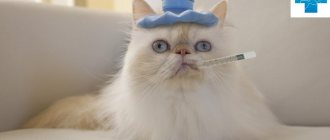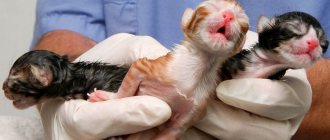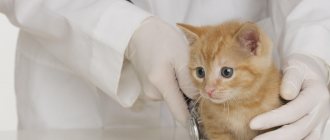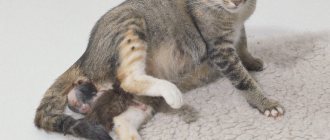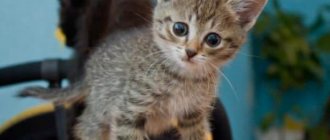8978Administration
1
Finally, the moment has come that the owners of their pet have been waiting for during 2.5 months of pregnancy. The cat, having settled comfortably in a pre-prepared place, begins to give birth to tiny and very cute kittens. However, people may not always understand that the cat has given birth to all the kittens, especially if this is the first time they have given birth to their pet. Moreover, the more kittens are born, the more anxiety it will bring to the owners.
What signs should you look out for?
When it comes to the fact that a cat may not give birth to all kittens, then this situation poses a danger to the pet, even to the point of death.
A fetus that is not born will eventually begin to decompose in the womb, releasing toxic substances that are harmful to the animal. How to determine if everything is okay and what help to provide to your pet? The birth is not considered complete if:
- the cat after giving birth is not interested in kittens and does not lick them;
- refuses food and water;
- a day later, the cat’s temperature rose to 39 degrees or higher;
- when the fetus appears, the cat does not change position and continues to periodically push;
- the abdomen is hard and tense on palpation, the fetus can be felt;
- after 2 days, urine and feces are colored scarlet, and an unpleasant odor emanates from the pot.
The birth process in a cat occurs in 3 stages. First, the cat begins to moan and meow, the cervix opens, and the birth plug with discharge comes out. In the second phase, contractions become intense, the cat tenses, and kittens begin to emerge through the birth canal.
It happens that a cat runs away in fright or gets lost during the first lambing; in this case, it is important to re-examine the kittens and, if necessary, cut the bladder with sterile scissors so that the cub does not suffocate. At the final stage, the placenta is separated; it is important to ensure that the cat does not eat the afterbirth or the stillborn (weak) kitten
If all the rules are followed, but there are still concerns that the cat has not completely given birth, it is important to contact a veterinarian for help.
At the final stage, the placenta is separated; it is important to ensure that the cat does not eat the afterbirth or the stillborn (weak) kitten. If all the rules are followed, but there are still concerns that the cat has not completely given birth, it is important to contact a veterinarian for help.
Signs of completion of labor in a cat
Calving went well and all kittens were born if the cat:
- Breathing is calm, temperature is normal.
- The cat licked and fed the offspring.
- He gets up on his own to drink and eat.
- He shows no signs of restlessness and is sleeping.
- The abdomen is soft on palpation.
Sometimes labor is interrupted without any signs of discomfort. This is a natural defense that is triggered if the cat is tired or abused. When the body recovers, calving continues after some time.
Alarming symptoms
An unqualified owner cannot always help a furry pet. That is why during childbirth you should have the telephone number of the treating veterinarian, or preferably two or three numbers, at hand. Four symptoms are a serious reason to contact a specialist.
Ahead of schedule. Most often, premature birth occurs in a cat due to a frozen pregnancy, non-viability of the offspring, placental abruption, or trauma. The stages of labor pass faster already on the 50-55th day, sometimes earlier. Most often, a cat gives birth to dead kittens. The living premature offspring dies in the coming days. It happens that a cat gives birth to just one dead baby prematurely. The rest emerge alive and healthy on time. If your cat gives birth prematurely, have her examined by a specialist to understand further steps. Lack of childbirth. If the pet does not give birth for more than 70 days and if this is not a false “birth” due to an imaginary pregnancy in the cat, then the pregnancy is probably frozen. The cubs most likely died, so it is urgent to save the pet from possible infections and damage to the uterus. Missed birth
It is important to determine when labor is truly over. If the pushing has stopped and the cat is resting, this does not guarantee that all the kittens will come out.
You should observe your mother's behavior. A cat that has not yet given birth reluctantly takes care of the cubs, does not leave the “nest” and does not change position, refuses to drink, and periodically strains. To make sure, you can feel the stomach three to four hours after birth. The elasticity and tension of the muscles indicate that there is still a kitten left in the womb. Discharge. Any colored, pungent-smelling discharge during pregnancy and childbirth is a deviation from the norm. During strong, long contractions (more than an hour) without subsequent labor, blood may flow profusely. In this case, it is also necessary to show the cat to a specialist.
Fetal pathologies do not always depend on the health of the mother and can be inherited from the father. However, the physical and mental condition of the cat affects the successful outcome of the birth.
Therefore, it is important that the pet is healthy before mating. Unfavorable factors for childbirth are old age, obesity, stress, heredity
Even the process of childbirth in a cat, supported by instincts, does not always go smoothly. You should mentally prepare for any outcome. However, do not panic prematurely and do not intervene without reason. Nervousness will be transferred to the pet, and during childbirth she will be confused. Rest assured that everything will go well and the cat will be able to rely on its owner.
This simple question is asked not only by experienced breeders of the breed, but also by ordinary owners of furry four-legged animals who expect a new addition to the family in the near future. But really, how can you tell if a cat is about to give birth?
? Let's try to figure this out.
Signs appearing within 7-10 days
Silence in a cat does not always mean that labor is over. Most animals do not change their behavior during and after birth. If you are unsure whether you have unborn children, consult your healthcare professional.
- The first signs of impending calving appear 7-10 days before the kittens appear, and this should be a signal to the owner that it is time to prepare a bed for the mother. It is not difficult to determine the beginning of the process of preparation for calving. The following behavior of a pregnant cat indicates that labor is imminent:
- Finding a quiet place with dim lights is the first sign that an animal is about to give birth;
- dragging rags in one place;
- spend a long time in an unfamiliar place.
The main signs of the end of labor
When a cat gives birth, it is important to make sure everything is successful in the end. This can be judged by the presence of the following signs:
- As soon as the mother realizes that all the kittens are out, she begins to actively care for the offspring, feeding them milk. At the same time, the cat intensively licks the babies, feeds them, purrs;
- If you listen to your breathing, you will find that it is even. Heart beats and pulse are rhythmic and follow at a normal speed;
- Mom eats and drinks with pleasure;
- the pet is able to get up and walk at least a little;
- when labor ends, if palpation is done no earlier than 40 minutes later, the abdomen will feel soft and relaxed to the touch. When palpating, you cannot feel the presence of seals. The muscles may be tense for a short period of time, but this quickly passes.
An indirect sign of a favorable end of labor may be the natural and calm behavior of the pet. However, it is normal for some cats to remain calm even when giving birth.
Signs that a cat has given birth completely
The belly of a giving birth cat, if it is assumed that all the kittens have come out, will be soft, without any lumps. You need to feel it carefully, without using force. But it is impossible to judge the end of labor by the size of the abdomen, since the cat’s uterus contracts slowly, and even after a day retains its tone.
The main guidelines indicating complete delivery are behavioral signs:
- The cat does not feel anxious, there are no attempts.
- The woman in labor is breathing smoothly, the heartbeat is rhythmic, the pulse is not rapid;
- The mother shows an active interest in the offspring, licks the kittens, feeds them, and moves them closer;
- She can change her body position, get up from the nest, and leave it for several minutes;
- After hard work, your pet feels increased appetite and thirst, eats and drinks with pleasure.
How does the feline birth process work?
Cats bear offspring for about 64 days, in rare cases - up to 70 days. On average, there are 3-5 kittens in a litter, but cases of the birth of eight cat cubs have been recorded. The duration of labor is influenced by several factors: age, number of fetuses, number of previous lambings, breed, diet during pregnancy. On average, the process of childbirth in cats takes from several hours to a day and a half, and includes periods of contractions, pushing and expulsion of the fetus.
The cat's first contractions may be invisible to others because they are still weak. At this time, your pet can be busy arranging the nest. As the contractions intensify, the cat may moan, meow, and its body periodically tenses in efforts. Then the cervix opens, the mucous birth plug emerges through the birth canal, followed by the first kitten.
Kittens are born “in order”, usually with a break of half an hour to 12 hours. Their birth may alternate with the expulsion of the placenta, which the cat sometimes eats. Kittens are born in the embryonic membrane (amniotic sac), the cat chews it, licks the cub, then bites the umbilical cord. The mother can begin feeding already born kittens in between contractions.
If your pet ignores the newborn kitten, the owner present at the birth will have to open the amniotic sac himself, carefully wipe the kitten and place it next to the mother. During the birthing process, your cat may need several hours of rest.
It is difficult for an inexperienced cat owner to understand whether all the kittens have already come out, or whether this is a break in childbirth. Even an ultrasound scan performed during pregnancy does not always reliably determine the exact number of fetuses. You can focus on the signs of the end of the birth process
During the birthing process, your cat may need several hours of rest. It is difficult for an inexperienced cat owner to understand whether all the kittens have already come out, or whether this is a break in childbirth. Even an ultrasound scan performed during pregnancy does not always reliably determine the exact number of fetuses. You can focus on the signs of the end of the birth process.
Duration of labor
For this to happen, the cat's general condition must be close to ideal, but this is uncommon given some "flaws" during the birthing process. But this, given some “glitches” at birth, does not happen often. In other words, some other option is needed. And if the cat has not yet given birth to her last kitten, then this is a cesarean section.
Your kitten should receive adequate nutrition and care throughout pregnancy. This directly determines how easy it will be to calve. The duration is very individual.
The firstborn takes a long time to give birth, she is frightened by pain and uncertainty, and contractions lengthen the calving period. The kittens are large, since the first time a cat gives birth to a maximum of three kittens. Older cats give birth quickly and in small numbers, with cats giving birth to six to eight cubs on average. Calving lasts from twelve hours to two days.
Kittens are born one after another. The first kitten from the start of the attempt is born in the first hour. The next ones are born at intervals of one to four hours.
- The duration of calving depends on many individual factors:
- Age of the cat
- Number of previous calves.
- Race.
- Individual physical characteristics.
- Quality of food consumed during pregnancy.
Signs of the end of labor
After forty minutes, the mother’s belly becomes soft.
The first symptom is active care of the offspring. The animal diligently licks the kittens, purrs, and feeds. The pet breathes evenly, the pulse and heartbeat are stably rhythmic and do not go beyond physiological parameters. After a short time, the cat shows interest in food and drink
The pet can get up from the nest and leaves its brood for a while. After forty minutes, the mother’s abdomen becomes soft; palpation does not reveal any lumps. However, the uterus may remain in good shape for some time, which can be mistaken for a kitten. In this case, you should not squeeze the cat’s stomach too much; you should place both hands on the sides of the animal and carefully move along the ribs. It is recommended to check after the forty-minute period has expired. An additional sign is the cat’s calm behavior, but due to the fact that some mothers behave calmly even during childbirth, this sign is not a 100% guarantee.
What to prepare for childbirth
At this stage, you should prepare the box and begin to accustom your pet to it. By the time she gives birth, she will get used to it and give birth to kittens in the right place.
- Any owner who will have a kitten should prepare for this event. Prepare especially carefully if your cat is about to give birth for the first time: you don’t know what complications you will encounter during childbirth. A pet may need the help of its owner, so you should make sure that the following items are available in the house:
- Soft disposable diapers;
- scissors;
- antiseptic solutions: chlorhexidine, hydrogen peroxide, potassium permanganate solution, green;
- petrolatum;
- sterile gauze wipes;
- clean pieces of cotton fabric;
- small syringe;
- sterile medical gloves.
It is necessary to arrange a nest in which the cat must give birth and then feed her kittens. To do this, you need to use a cardboard box or buy a ready-made one at a pet store. We put oilcloth on the bottom of the house or box, then soft cloth, and disposable diapers on top. The house should be shown to the cat in advance so that it can get used to it. Place your pet's future home in a warm and secluded place, but do not place it near heating appliances.
If the owner notices signs of labor and knows for sure that the cat is about to give birth in the next 24 hours, notify the veterinarian so that he can come when called. This is necessary in case of an emergency when the animal may require the help of a specialist. In general, difficulties may arise for purebred kittens giving birth for the first time. Pedigree cats are more likely to go through this process more easily.
How to understand that a cat is giving birth: main signs
On average, pregnancy in cats lasts 65 days (plus or minus 5 days). This period usually guarantees the birth of healthy kittens. But how to know that a cat is giving birth - not every person knows the signs of this event. Many inexperienced owners begin to worry about the upcoming event as soon as they notice that their pet is pregnant. The owner of a cat who is about to give birth for the first time experiences special experiences. And the pet itself often shows anxiety. And I must say: not in vain.
But don't worry too much. You will have enough time to become familiar with the cat's behavior during this period and prepare the necessary supplies for giving birth at home. First, let's try to understand what signs can be used to guess that a cat is pregnant. It will be easiest to recognize an “interesting position” and calculate the date of fertilization if the mating was planned, and you know from what point to keep a record of the pregnancy, which is conventionally divided into three stages with characteristics characteristic of each.
What to do if the cat cannot give birth to the “last baby”?
Once again we would like to emphasize that only a veterinarian and only with the help of an ultrasound (and in the worst case, an x-ray) can accurately determine the presence of “late” kittens. On our own, we would not recommend touching or tugging at the animal’s belly. So it is difficult to understand whether the cat gave birth to all the kittens, but it is entirely within your power to harm the animal.
So, there is a calf in the womb. For some reason, the cat cannot give birth on her own. What to do? If the animal is not too emaciated and the abdominal and uterine muscles are contracting normally, an attempt can be made to induce a “second stage” of labor by injecting oxytocin. Including In any case, there is a chance that the resumption of contractions will help solve the problem.
But it is necessary to remember that oxytocin is not the safest drug, so when using it, several important nuances should be taken into account:
- If after the first dose (no more than 5 IU) there are no signs of seizures, further administration should be considered pointless and even dangerous.
- If the cat's body temperature is below 37.5° Celsius, there is no need to artificially induce labor.
- Bradycardia, tachycardia, and other cardiac or respiratory disorders are also contraindications for taking oxytocin.
How to prepare a cat for childbirth?
In the last week of pregnancy, it is recommended to protect the cat from stress as much as possible. The expectant mother's bed, tray and bowls must be moved to the most remote and quiet room
It is important that there are no drafts in the room and a constant temperature regime is maintained.
1-2 weeks before giving birth, most cats begin what is called nesting. The pet is looking for a secluded, dark, quiet and warm place in which she will give birth and raise kittens.
In most cases, cats prefer to make a nest in closets or under the bed. The expectant mother, who has free access to the street, is likely to build a nest outside the house, for example, under a threshold or in an improvised hole.
Note that giving birth to kittens in a closet is convenient for the cat, but not for the owner. Monitoring the growth and development of kittens involves regular weighing. Temperamental and primiparous cats may become protective of their offspring, making kittens difficult to obtain. By arranging a nest for a cat and her future offspring in advance, you will eliminate a number of problems in the first month of the kittens’ life.
As a nest, you can use special boxes that are sold in a pet store or a regular, durable cardboard box. Experience shows that cats prefer to build their nests in a closed box with a roof. The side of the box is cut so that the cat can easily step over the threshold without clinging to its stomach.
During the birth process, the bedding in the box will be wet, so it is recommended to stock up on moisture-absorbing diapers. For the first 4–5 days after birth, until the babies' umbilical cords fall off, it is recommended to use only white cotton fabric as bedding. On white bedding, you will immediately notice dirt or suspicious discharge from your cat.
In addition to arranging the nest, you need to take care of preparing an emergency first aid kit. If the birth occurs without complications, your intervention will not be required.
In case of difficult labor and the need to open the amniotic sac, you will need several pairs of sterile surgical gloves. If the cat refuses to lick the kittens, amniotic fluid must be removed from their respiratory tract, and for this it is convenient to use a baby syringe or a syringe with a soft tube.
For any complications during the birth process, it is recommended to contact a veterinarian. Arrange in advance with your doctor about telephone consultations and home visits, if necessary.
In rare cases, the umbilical cord vessels do not close, so they have to be ligated. You can use strong cotton, nylon or dental floss as a dressing.
Use sharp, sterile scissors to cut the umbilical cord. Pour boiling water over the scissors in advance or treat them with alcohol, then place them in a clean bag and do not take them out until delivery.
In addition to moisture-absorbing diapers, which are used as bedding, you need to stock up on a large number of cotton pieces to wipe and wrap the kittens.
Just in case, prepare several terry towels that retain temperature well. In case of complications, you will have to remove the kittens from the nest, so a spare box of bedding and a heating pad will be useful.
After the first or difficult birth, some cats refuse kittens, that is, they ignore and do not feed them. To take control of the situation, buy several packets of milk replacer and a kitten feeding bottle in advance.
How to care for a cat after giving birth
Caring for your pet should begin even before labor begins in order to prepare for the crucial moment, which can begin at any moment. You also need to continue to pay attention after the end of labor.
- It is absolutely necessary in advance, even before the birth, to equip a place for childbirth and show these places to the woman in labor. Prepare a box or build some kind of house. In some cases, the cat may ignore these signals and find secret places on its own. If this happens, carefully move it to the prepared place.
- Place a snack and water nearby so that if she is thirsty or hungry, she can easily reach the food.
- Be sure to place the toilet nearby so that the mother can be close to her offspring and keep an eye on them.
- Don't hide kittens from their mother. When children are not in her field of vision, she begins to get nervous, and if she sees that a person poses a threat, she may change in behavior.
- Children and guests do not need to touch newborns; let only one person do this so that the pet can trust her offspring.
- Provide dim lighting, warmth, soft blankets and bedding. Bright light will have an adverse effect on the eyes of mole rats.
- Prepare diapers and towels to ensure hygiene. Usually they themselves lick off the remains of food after labor, but some tailed animals may not be able to do this. Inspect the genitals and wash them with damp cloths. Change the diaper when it gets dirty.
- There is no need to put your cat on a diet after giving birth; on the contrary, give her as much food as she requires. This is necessary for her body to provide food for small children.
- If the tailed one loved to walk outside before giving birth, now you can forget about it. While the kittens are small and fragile, it is worth prohibiting walks, even if she really wants it. During her walks, she picks up a lot of bacteria, which she can then pass on to her children, and their bodies are still very weak to bear it. Also, prohibitions on walking will protect against the next birth, because estrus may start again, and under no circumstances should you become pregnant so quickly.
- Monitor the body's behavior: check the temperature, monitor postpartum discharge, nipple discharge.
- Small children should not be allowed out into open areas, onto the floor or onto sofas. The mother will not approve of this, but there will be danger: falling or catching a cold.
Watch the offspring and mother at this happy moment. If the health of the mother or babies becomes suspicious, contact your veterinarian. The cat must be as healthy and happy as possible, and the kittens must grow up strong.
The birth of a new life is a great process given to us by nature and such an event is especially valuable for a cat.
What you need to know about cat pregnancy
The cat owner can calculate the approximate due date in advance. Pregnancy in an animal lasts approximately 60-65 days. Premature kittens are healthy.
- If your cat shows abnormal signs during pregnancy, there is a chance that labor may begin prematurely. To ensure that your cat gives birth to a healthy litter and that the pregnancy does not end tragically, be sure to visit your veterinarian throughout the pregnancy. This is especially important in case of complications. During pregnancy.
- There are some factors that influence when a cat can be born. These include race, health and body size. The age of first pregnancy can range from 5 months to 18 months. Veterinarians agree that only a mature cat can give birth to kittens from about 12 months of age. Readiness is expressed through restless behavior, loss of appetite, poor sleep, urgent dusting and a characteristic attitude (falling on the forelimb, arching the hindquarters).
- You can tell if your pet is pregnant after some symptoms:
- Fatigue (lethargy, phlegmatic, drowsiness);
Toxicity (morning vomiting);
Kittens in the first months of life
Kittens should be with their mother for the first two months. Those wishing to purchase a “kitten for the palm of your hand” should be advised that their pet, when it gets to a new home, will already be larger than the palm of your hand, because You won’t give it back before 3 months. This will be humane both in relation to the children and in relation to the mother, whose kittens will not be taken away prematurely.
In the meantime, your task as a breeder is to provide all conditions for the babies. This is, first of all, a cozy, warm nest in an impenetrable place. This is a lack of increased interest on the part of family members and strangers. This is a minimal concern in terms of making sure their mother is feeding and washing them. Pay special attention to whether there is enough milk for everyone. If you see kittens squeaking and crawling unsatisfied in search of the breast, although the cat seemed to be feeding them, this is a sign that there is not enough milk for everyone. Then you will need to feed with goat's milk or a special purchased formula for kittens in the first days of life. You will also have to feed them yourself if the mother is now unable to do this: for example, she had a caesarean section and is recovering from anesthesia, as happened with the cat in the video below.
Also look at whether the cat licks each baby. The fact is that newborn kittens themselves cannot empty their bladder and intestines, and stimulation by their mother’s tongue helps them with this. If the cat does not lick them in the area of the butt and tummy, thereby doing a massage, you will either have to do this carefully with one finger, or try to spread tasty oil (for example, fish oil) under the babies’ tails - the cat will immediately fall in love with the licking procedure.
Stages of lambing for a cat
The physiological feature of the structure of the cat’s uterus is that it resembles the English letter U. The area of the cervix is located at the end of the reproductive organ and serves as a specific barrier against the penetration of pathogenic microflora into the uterus with fetuses. The cervix is closed by a mucous plug. Childbirth in a cat begins with the release of the mucous plug.
Embryos communicate with the maternal body using the umbilical cord, receiving all the necessary beneficial components through the feto-placental barrier. It plays the role of protection, filters blood from the mother’s body before it enters the baby’s body. In addition, the baby's place or placenta transports nutrients to the babies' bodies. Before giving birth, a cat's discharge begins to appear in the form of pinkish mucus, sometimes streaked with blood.
There are several stages in the development of the birth process. The following are distinguished:
- The initial stage is when the cat’s reproductive organ muscles begin to spasm before giving birth. From the area of the vagina and loop, the pet receives a specific secretion, called a mucous plug, which closes the uterus throughout the entire period of bearing babies. In the very first stages, contractions of the uterus, called contractions, occur. With the development of the physiological process, contractions begin to become more frequent, and the period between them decreases. The animal breathes frequently, and hypersalivation (secretion of a large amount of saliva) may begin. The cervical area gradually opens up to allow the babies to emerge from the birth canal.
- The second stage is characterized by an increase in contractions and an increase in their strength. The cervix at this moment opens as much as possible. A similar phenomenon occurs under the influence of hormonal substances. During this period, the animal is ready to give birth, and the first fetus has moved into the birth canal. The baby presses on the cervix, and contractions of the muscle fibers gradually push the kitten towards the exit through the vagina. Kittens are often born directly in the membranes, but it also happens that the amniotic sac bursts as the kitten passes through the birth canal. The cat is tense in the second stage. As soon as the first kitten is born, the cat begins to clean the baby from the bubble and films. If a kitten is born in a bladder, the mother cat breaks it, licks the baby's face and body, thereby stimulating the respiratory tract. The duration of the second stage is from 10 minutes to 1 hour. If the kitten does not appear 1 hour after pushing, you must notify your veterinarian.
- The third stage is characterized by the release of the placenta after the first kitten. The cat independently gnaws the umbilical cord, eats the placenta, copes with breathing and begins to care for the first kitten that appears. It is important to count the number of placentas after each kitten appears. It is recommended to record the number of children's places left on a separate sheet. If one placenta does not come out in a timely manner, it can cause the development of serious inflammatory processes in the birth canal, causing dangerous complications for the woman in labor.
Scottish cat gave birth to kittens: caring for mother and offspring
If your Scottish Fold or Straight cat has given birth to kittens, there will be joy in your home. This is an incomparable feeling of the birth of a new life! The kittens are so cute that you want to cuddle them. They squeak, crawl around the mother, and she collects them in a heap and selflessly looks after the tailed ones, feeds them and licks them, purrs: it seems that such a life is complete peace. But not only pleasant moments are associated with the appearance of kittens in the house, but also with various difficulties. We'll talk about them.
Labor has begun!
When your cat has her first contractions, she may scream loudly. This means the process has begun. But before the first newborn furbaby is born, the kitty has a lot to deal with. Much also depends on the behavior of the owner. The animal is already helpless and scared, and if household members run around and loudly discuss what is happening, this will cause great discomfort and suffering to the cat.
Childbirth in a cat goes through several stages:
- The waters are receding.
- The cervix and birth canal open.
- The first cub appears (each next kitten will come out after 15-30 minutes).
- The placenta emerges from the uterine cavity.
Cat birth is not uncommon, but the pet needs to be taken seriously. A loving owner will definitely go to the pharmacy in advance and buy the following products:
- sterile gauze;
- small towel;
- scissors;
- pipette;
- warmer;
- baby cream or Vaseline.





